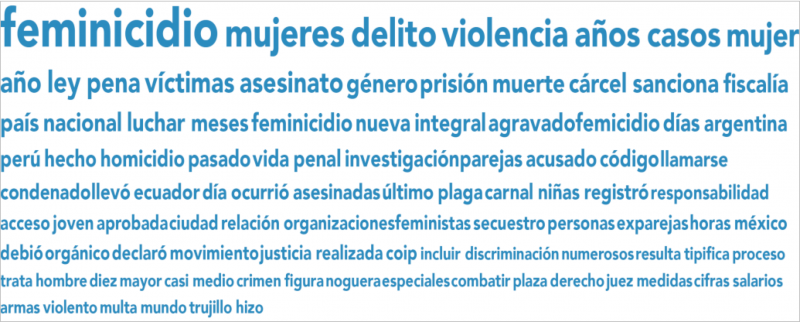“The survivors are not represented, as well as the indirect victims of feminicide”
The Reframed Stories Project asks people to respond to dominant themes and issues that appear in news coverage about their communities. These stories are reflections by people who are frequently represented by others in the media. Word clouds are created using the Media Cloud platform, a data analysis tool which examines a collection of media outlets over a specific period of time, allowing participants to analyze and discuss preliminary insights into how they might be represented in the media. The project refrains from making conclusive pronouncements about the data, and instead is a starting point that creates space for discussion about how they can help shape their own media representation through digital media.
Darío Castro is an activist and helped in the creation of the Institute for Gender Equality and Rights (INIGED) of the Central University of Ecuador. The following is a transcript of the video about Darío's analysis of the word cloud for the term, “feminicidio” (feminicide).

Dominant words from articles published between January 2017 and April 2018 mentioning “criminalización” (141 articles) within 2 Media Cloud collections of Ecuador’s Spanish-language media outlets. (view larger image)
What about the word cloud drew your attention most?
La palabra que escogí para hablar de nosotros fue feminicidio. Nos interesaba reconocer cómo somos representadas sólo como víctimas de la violencia, somos cuerpos asesinados simplemente y somos voces acalladas. Nos preocupa que en el análisis de la nube, siempre seamos de alguna forma objetos que han desaparecido o que se han muerto, y no corresponde con la realidad porque no nos matan solamente en el acto mismo del feminicidio.
We are interested in recognizing how we are represented only as victims of violence, we are simply bodies that have been murdered, and that we are silenced voices. We are concerned that in the analysis of the [word] cloud, we are always in some way objects that have disappeared or that have died. That does not correspond with reality because they do not kill us only in the very act of feminicide.
According to the word cloud, how has ‘feminicide’ been represented in the media?
Me sorprende que los medios tengan muy claro que la violencia es la expresión
máxima del ámbito patriarcal machista, que se enuncia en términos legales lo que vivimos, pero también me sorprende lo que no está. Y no están los nombres de las de las víctimas, no está el señalamiento que existimos las sobrevivientes también en el proceso de los feminicidios. (Esto) nos asusta y nos lleva a pensar por qué en el feminicidio no está el principal actor, el responsable máximo de esto que es el estado como un agresor, que no vela ni cuida. Además, no permite que la resistencia, feminista o no, se dé en los espacios reales de la vida de las mujeres.
I am surprised that the media is very clear that violence is the maximum expression in the patriarchal sexist [society] which is stated in legal terms what we live, but it also surprises me [what is not present in the word cloud]: the names of the victims, the signaling that survivors do exist, also the process that feminicides [are carried out] is also not there [in the word cloud], and that scares us. It leads us to think the principal actor and the person ultimately responsible is not represented. The feminist resistance in the real-life spaces are not represented in women’s lives.
How should feminicide be represented in the media?
Nosotras creíamos que debían estar posicionados exactamente quiénes son los co-responsables del asesinato de las mujeres, y evidenciamos que entre lo que nosotras creíamos que debe haber y lo que los medios posicionan hay una distancia enorme porque no se señalan quiénes son los culpables, no está el estado, no están con nombres claros las personas que conviven con nosotras y que son las que deciden hacer el acto del feminicidio. Y sentimos que tampoco estamos ahí representadas como las sobrevivientes de eso, ni las víctimas indirectas de un feminicidio. Los medios sólo nos ven como costales de carne, como sangre y como personas víctimas de una violencia ante la cuál no ofrecemos ninguna resistencia.
We believe that the co-responsibles for the murder of women should be represented, and we believe that there is a huge distance because the [media] does not point out who are those guilty [of feminicides]. The State and the real names of those that live among us and who ultimately decide to carry about feminicides (are missing). We also feel that the survivors are not represented, as well as the indirect victims of feminicide. The media only sees us as sacks of flesh, as blood, and as victims of violence that offer no resistance to [feminicide].
This is part of a Rising Frames series developed in close collaboration with the organization El Churo based in Quito, Ecuador. They organized a workshop held on April 21, 2018 that brought together representatives from various collectives and groups to examine how they or issues they care about are represented in a collection of Ecuadorian media and to create stories in response.











